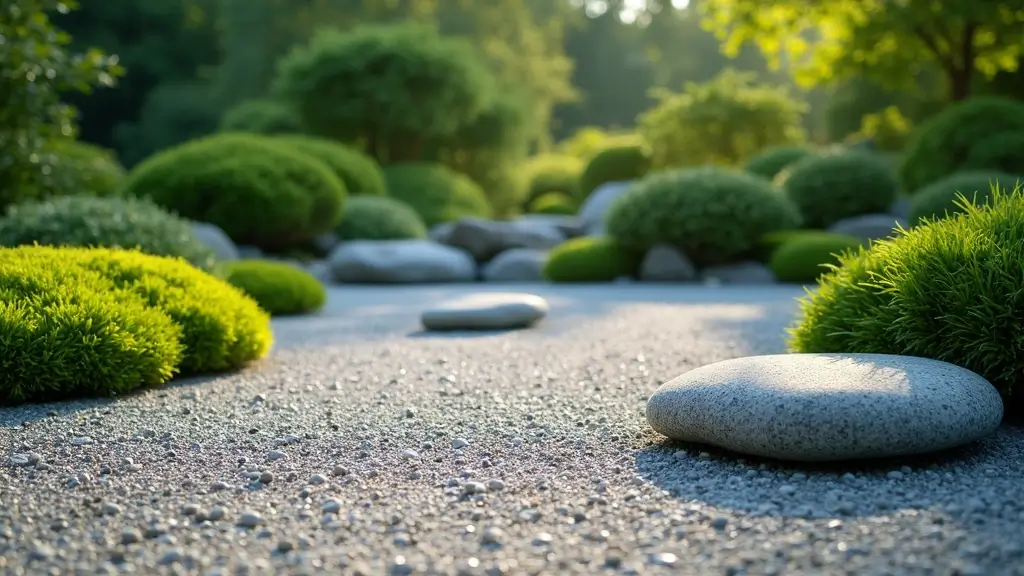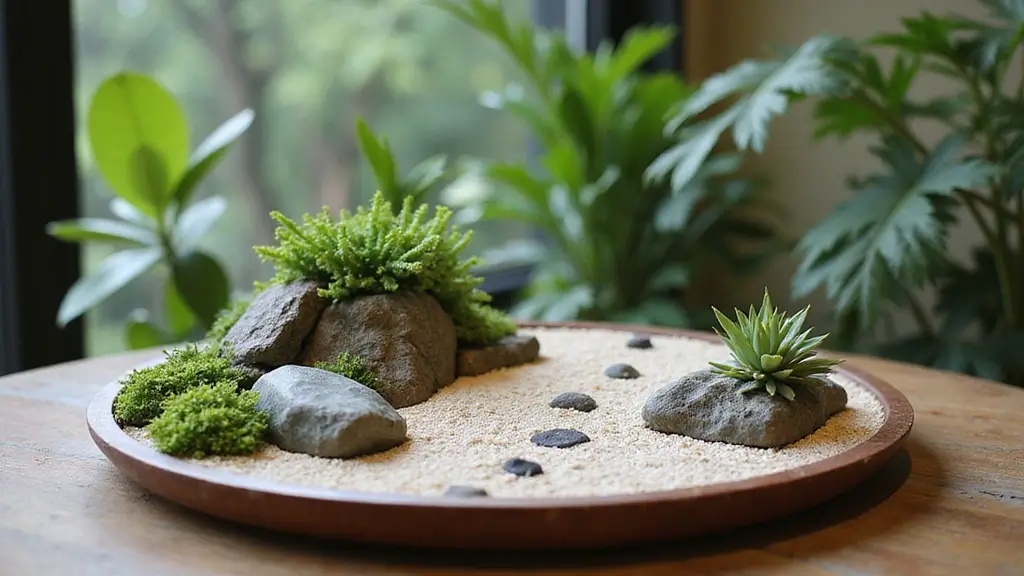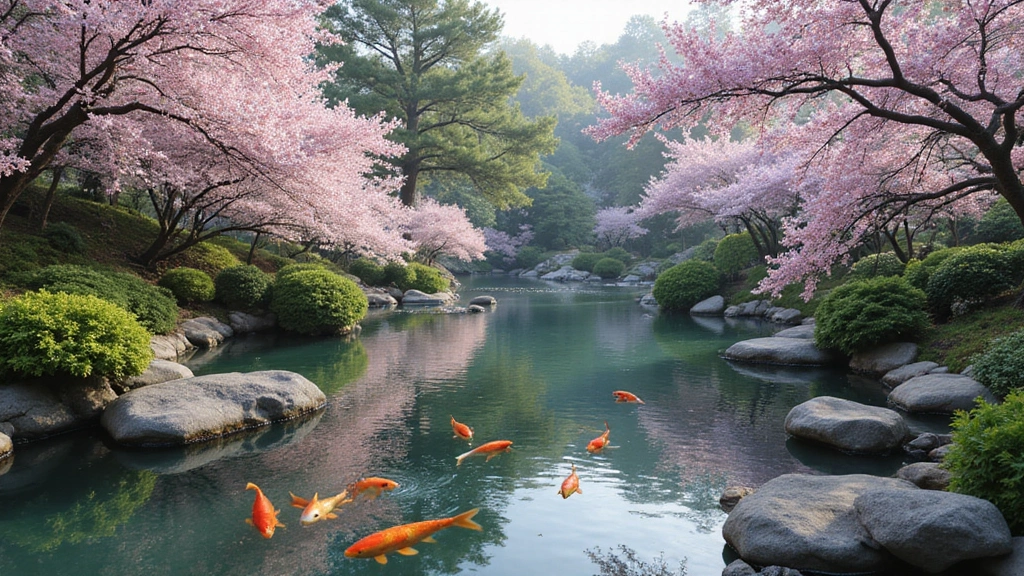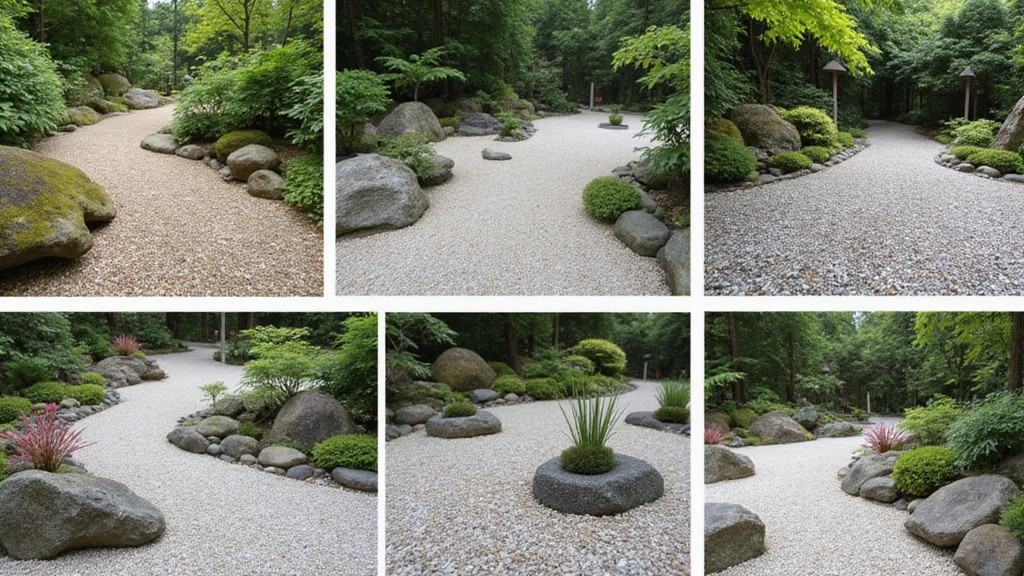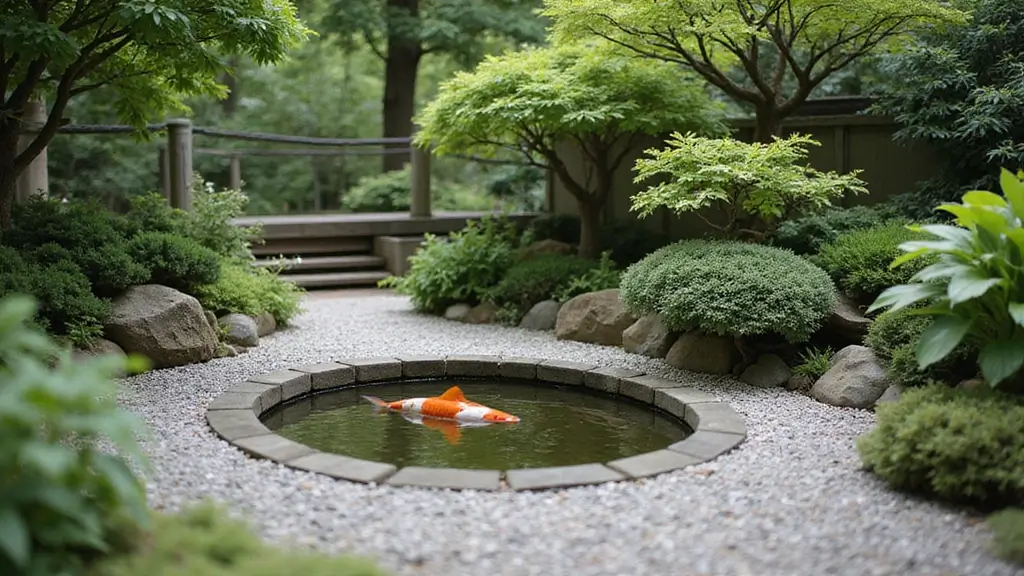Creating a zen garden is more than just putting a few rocks together. It’s about cultivating a serene space that invites peace and mindfulness. The beauty of these gardens lies in their simplicity and the careful orchestration of elements that reflect nature’s harmony. From soft raked gravel to carefully placed stones, every design choice plays a role in achieving balance.
This guide dives into 27 essential principles that will help you create the ultimate zen garden. Whether you’re a seasoned gardener or a newbie looking for a tranquil retreat, these tips will inspire you to design a space that brings serenity into your daily life. Let’s explore the elements that make zen gardens so special and how you can incorporate sustainable gardening practices through effective composting techniques for a truly organic experience.
1. Minimalist Aesthetic

The core of any zen garden is its minimalist aesthetic. By keeping designs simple, you encourage tranquility and reflection. Start with clean lines and a limited palette. Utilizing materials like gravel, sand, or rocks can effectively represent water and land without cluttering the visual space.
Here are some tips for achieving this look:
– Limit the number of plants to a few carefully chosen species.
– Choose monochromatic colors for stones and gravel.
– Remove any excessive decorations that distract the eye.
In this regard, gravel for landscaping can serve as an excellent choice, providing a clean, uniform look that harmonizes with the surrounding elements. Additionally, incorporating natural river stones adds both texture and visual interest while maintaining the serene simplicity of your garden.
For maintenance, a zen garden rake is essential. This tool will help you easily create patterns in the sand or gravel, allowing for a mindful, peaceful gardening experience.
The emphasis on minimalism not only creates visual peace but also makes maintenance easier. Less clutter means more time spent enjoying the serenity of your garden.
2. Balance of Elements

Achieving balance in your zen garden is crucial. It involves the thoughtful arrangement of elements like rocks, plants, and water features to create a harmonious space. Aim for symmetry or asymmetry based on what feels right for you.
To build balance, consider the following:
– Use an odd number of plants or stones for a natural feel. Incorporating decorative stones for zen garden can help achieve this, as they come in an assortment of sizes and provide an organic touch to your space.
– Alternate heights and forms to maintain interest. For this, a zen garden rake can assist in shaping and positioning your sand or gravel, allowing you to create unique patterns that evoke tranquility.
– Balance hard surfaces with soft foliage. Adding a water feature for zen garden can introduce soothing sounds and a serene visual element, enhancing the overall ambiance while softening the harder textures of stones and pathways.
By careful placement and the selection of these products, you evoke a sense of calm and encourage mindfulness as you move through the garden. Every element should feel intentional, contributing to the overall sense of harmony.
3. Pathways of Tranquility

Pathways are essential for guiding visitors through a zen garden while promoting a sense of journey. Whether it’s a simple gravel path or stone slabs, these routes encourage mindful walking and reflection.
To create soothing pathways that enhance your garden’s tranquility, consider using natural materials that harmonize with the environment. For instance, natural stone pavers like the Emsco Group Flat Rock Rain Barrel and AC Unit Paver Patio Pad provide a beautiful and easy-to-install option for creating serene walkways.
Curve the paths gently to mimic natural flow, allowing the experience of walking to become more meditative. Soft, flowing edges enhance this effect; introducing wooden garden edging can help achieve this by defining borders while maintaining an organic look.
Finally, consider using zen garden gravel to create a calming surface underfoot. This gravel not only promotes mindful movement but also invites deeper connection with the environment, further promoting an inner sense of calm.
With these thoughtful elements, your pathways will guide visitors through a serene journey, fostering reflection and tranquility in your zen garden.
4. Water Features
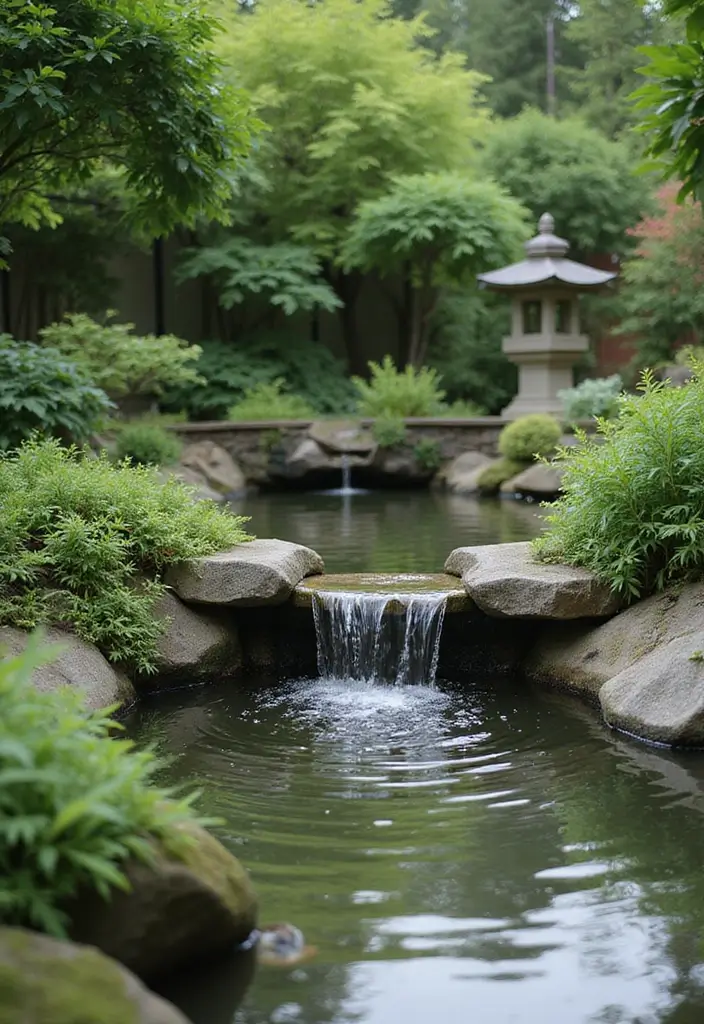
Water is a crucial component of zen garden design, symbolizing purity and tranquility. Whether it’s a pond, fountain, or a simple water bowl, these elements can enhance the serenity of your space.
To incorporate water effectively:
– Choose low-maintenance features that fit your garden’s scale. A great option is the Solar Fountain Pump, which is a mini solar-powered fountain that adds dynamic movement and soothing sounds to your garden without the hassle of wiring or high maintenance.
– Position the water element where it can be viewed and heard. The gentle trickle provided by a fountain can significantly contribute to the calming atmosphere.
– Consider adding aquatic plants for added beauty and natural filtration. The Aquatic Plants Starter Kit comes with essential tools for caring for your plants, making it easier to create a lush environment that complements your water feature.
Additionally, you might want to incorporate a decorative aspect with a decorative water bowl. Placing one in your garden can serve as a focal point while providing a tranquil space for reflection.
The sound and movement of water create a soothing background, inviting visitors to pause, reflect, and enjoy the moment.
5. Organic Waste Management
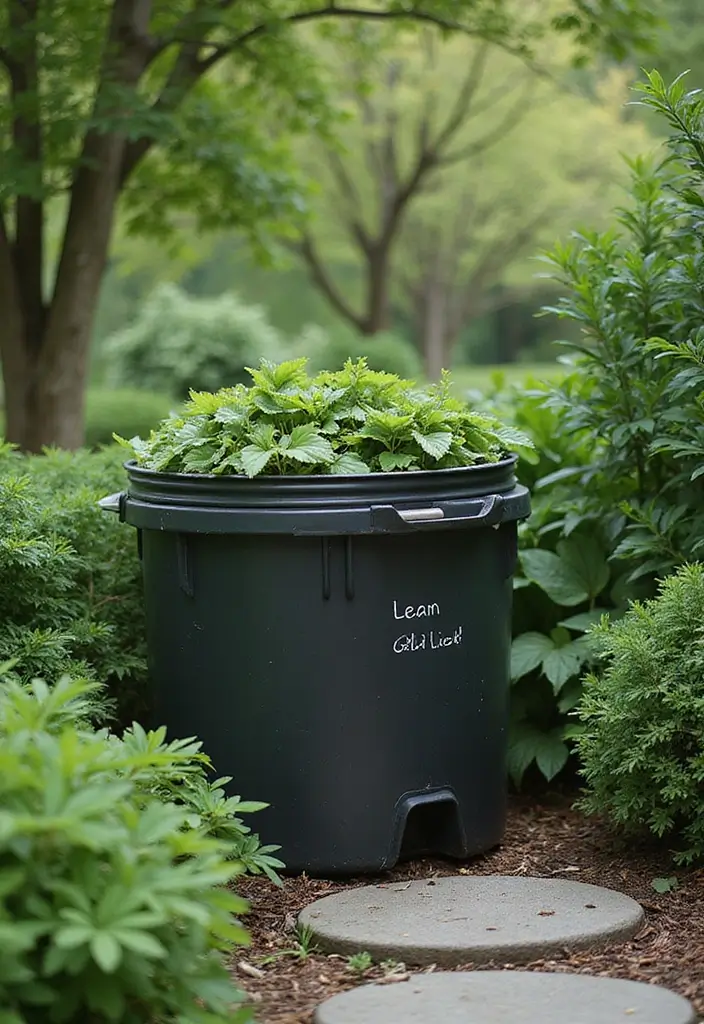
Sustainable gardening practices can be seamlessly integrated into your zen garden design. One effective way to manage organic waste is through composting, which transforms kitchen scraps into nutrient-rich soil. This practice not only benefits the environment but also enhances the health of your garden.
To get started with composting, consider investing in a compost bin like the Utopia Kitchen Compost Bin. Its compact design allows it to fit neatly on your kitchen countertop while keeping odors contained.
You’ll want to include a mix of green (nitrogen-rich) and brown (carbon-rich) materials in your compost. Using compostable kitchen scraps bags from UNNI makes collecting organic waste easy and eco-friendly. These extra thick bags are designed to hold food scraps securely until you’re ready to add them to your compost.
To ensure your compost breaks down efficiently, it’s important to keep it moist and aerated. The EJWOX Stainless Steel Compost Aerator Tool is a fantastic addition to your composting toolkit. With this compost aerator, you’ll be able to turn and mix your compost with ease, promoting faster decomposition.
By composting, you enrich your garden soil naturally, fostering a vibrant ecosystem that thrives on balance and sustainability.
6. Symbolic Stones

Stones carry immense symbolic weight in zen garden design, representing stability and permanence. Incorporating different types of stones can add texture and visual interest, enhancing the serene atmosphere you’re aiming for.
Consider using large boulders, such as Large Decorative Boulders, to create focal points in your garden. Their realistic natural texture can evoke the feeling of strength and grounding. Smaller stones, like Natural River Stones, can be arranged to symbolize flowing water, adding a dynamic element that encourages contemplation.
For added depth, consider integrating Colored Gravel for Landscaping with its polished mini stones. This can enhance visual interest and complement your stones, creating a harmonious environment.
Every stone should feel purposeful, inviting contemplation and contributing to the overall energy of the garden.
7. Plant Selection
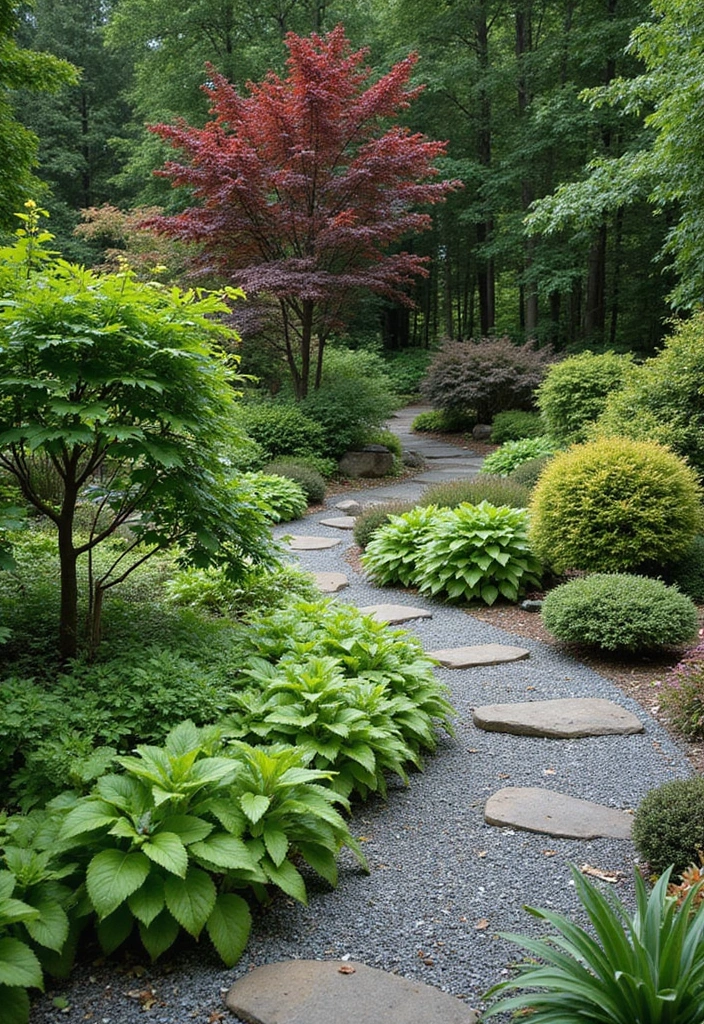
Choosing the right plants for your zen garden is key to promoting tranquility. Aim for a selection of greenery that offers different textures and colors while maintaining harmony.
Here’s a list of considerations for plant selection:
– Opt for native plants that require less maintenance, such as the California Wildflower Mixture – Bulk 1 Ounce Packet, which contains over 7,000 native seeds. These plants not only thrive in their natural environment but also attract local wildlife, enhancing the garden’s ecosystem.
– Incorporate evergreen plants for year-round greenery. A great choice is the Southern Living Sunshine Ligustrum, which will provide a lush backdrop even in the colder months, maintaining the serene essence of your garden.
– Choose flowering plants that bloom at different times to ensure seasonal interest. The Live Flowering Hardy Chrysanthemum – Red is a perfect option, adding vibrant colors in the fall with beautiful blooms that can lift your spirits.
Plants should encourage a sense of peace and enhance the overall calming effect of the garden.
In a zen garden, the right plants are not just decor—they’re your allies in creating tranquility. Choose wisely, and let nature’s harmony wash over you.
8. Natural Materials

In zen garden design, the choice of materials can greatly impact the overall feel of the space. Using natural materials like untreated wood, stone, and gravel helps create an organic look that blends seamlessly with nature.
When selecting materials, keep these tips in mind:
– Consider the untreated wood garden bench for seating areas or garden borders. This option maintains organic integrity and adds a rustic charm to your space.
– Choose locally-sourced stones or options like natural stone decorative gravel. This product minimizes environmental impact while enhancing the visual appeal of your garden.
– Opt for organic sand for zen gardens that complements the other elements. This fine white sand can enrich the texture of your garden, adding to the serene atmosphere.
Natural materials contribute to a sense of harmony and sustainability in your garden, making it a peaceful retreat.
Natural materials are the heartbeat of zen garden design; they connect us to nature and create harmony. Choose wisely, and watch your garden transform into a serene escape.
9. Seasonal Adaptability
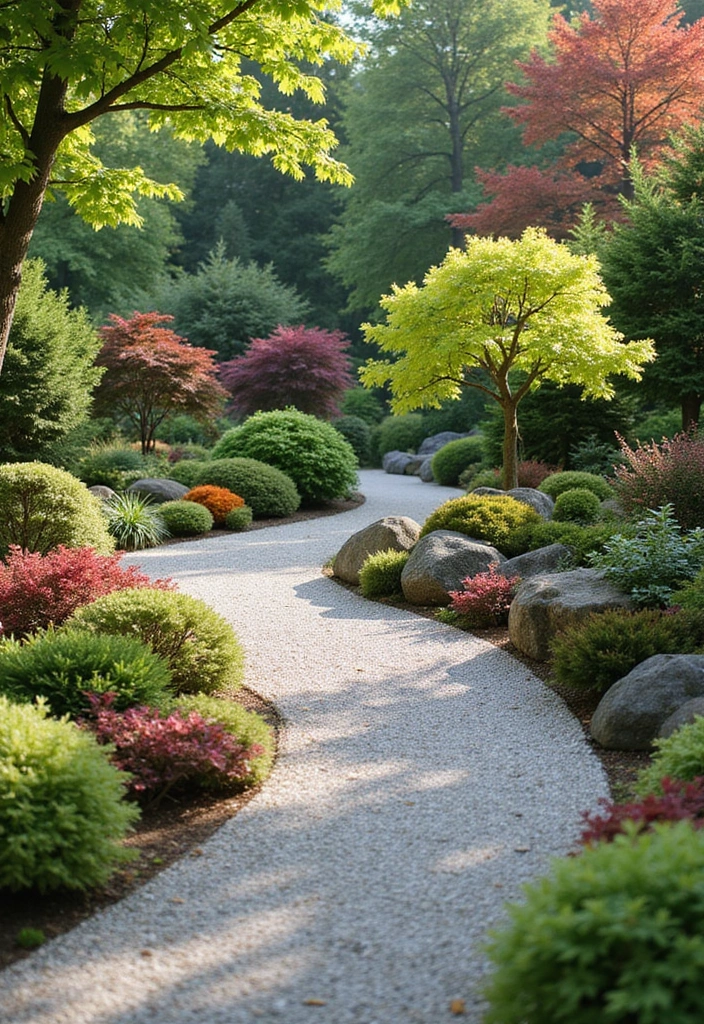
Designing a zen garden that adapts to the seasons can enhance its beauty and tranquility year-round. Consider how your plant choices and layout can reflect the changing seasons.
Here are some ways to promote seasonal adaptability:
– Incorporate deciduous plants that change color in fall, such as the Live Plant from Green Promise Farms – Gibraltar Azalea. This vibrant addition can bring stunning orange flowers to your garden and create a warm, inviting atmosphere as the leaves transition.
– Use evergreens for structure during winter months, like the 2 Gal. Obsession Nandina Shrub. This shrub provides year-round greenery, ensuring your garden remains visually appealing even in the coldest months.
– Include early bloomers and fall perennials for continuous interest with options like the Burpee Wildflower 25,000 Bulk, 1 Bag, which offers a mix of 18 varieties of non-GMO flower seeds. These perennial blooms will provide color and life through multiple seasons, inviting you to enjoy your garden throughout the year.
By planning for seasonal change with these thoughtful choices, you create a dynamic space that encourages ongoing appreciation and mindfulness.
10. Mindful Maintenance
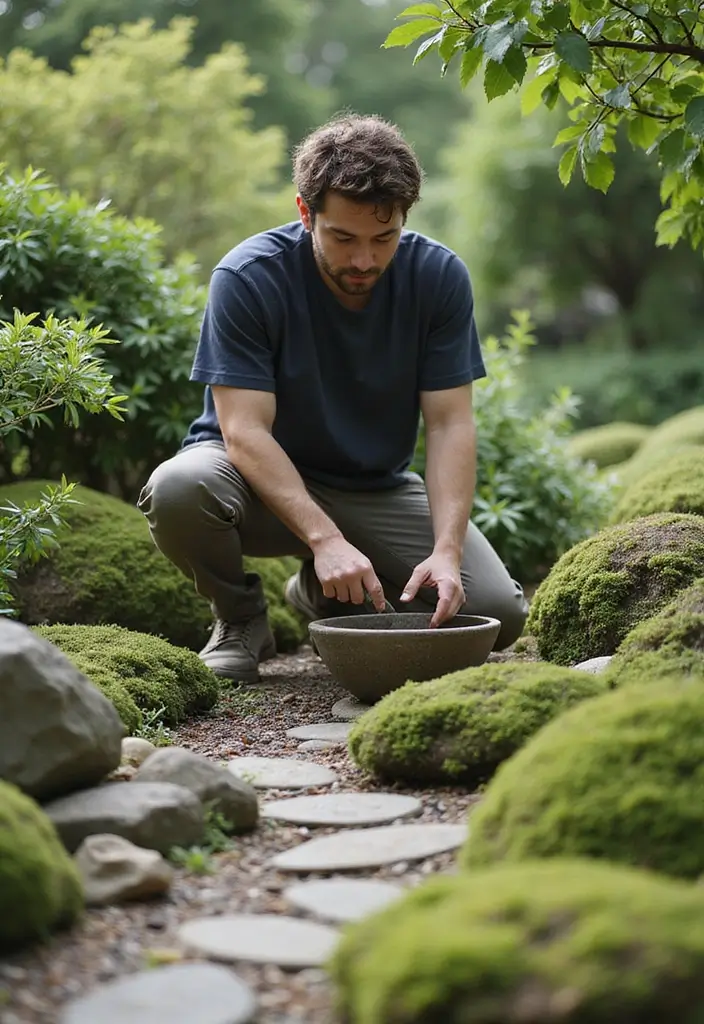
Maintenance is a critical aspect of zen gardening that requires mindfulness and intention. Rather than viewing it as a chore, consider it a meditation practice in itself.
Here’s how to maintain your garden mindfully:
– Schedule regular maintenance to keep plants healthy. Using an effective product like Bonide Captain Jack’s Neem Oil, an organic pest control spray, allows you to prioritize natural methods over chemicals for pest control, fostering a healthier garden environment.
– Use the time spent gardening as a moment for reflection. A comfortable spot to sit and contemplate can enhance this experience; consider a meditation garden bench to create a peaceful nook in your garden where you can connect with nature.
– Invest in a quality gardening tool set that features ergonomic handles, making your maintenance tasks easier and more enjoyable. This can transform routine work into an engaging practice of mindfulness.
When done mindfully, maintenance fosters a deeper connection to your garden and enhances its tranquil essence.
11. Creating Focal Points

A focal point can draw attention and serve as an anchor in your zen garden design. This can be anything from a beautifully shaped tree, like a potted bonsai tree, to an intricate stone arrangement.
To create effective focal points:
– Select elements that contrast with the surrounding space. For example, a decorative feature such as a decorative garden stone can add unique texture and interest while standing out against the natural elements of your garden.
– Use height and color to draw the eye. Consider incorporating garden lanterns that not only illuminate your space but also add visual appeal with their vibrant designs.
– Position the focal point in a way that invites observation from various angles. The placement of a striking bonsai tree can create a serene anchor that enhances the garden’s meditative quality.
Focal points not only add interest but also encourage deeper contemplation, enhancing the garden’s meditative quality.
In a zen garden design, a well-placed focal point invites contemplation. Contrast, height, and color can transform a simple element into a serene anchor for your space!
12. Color Harmony
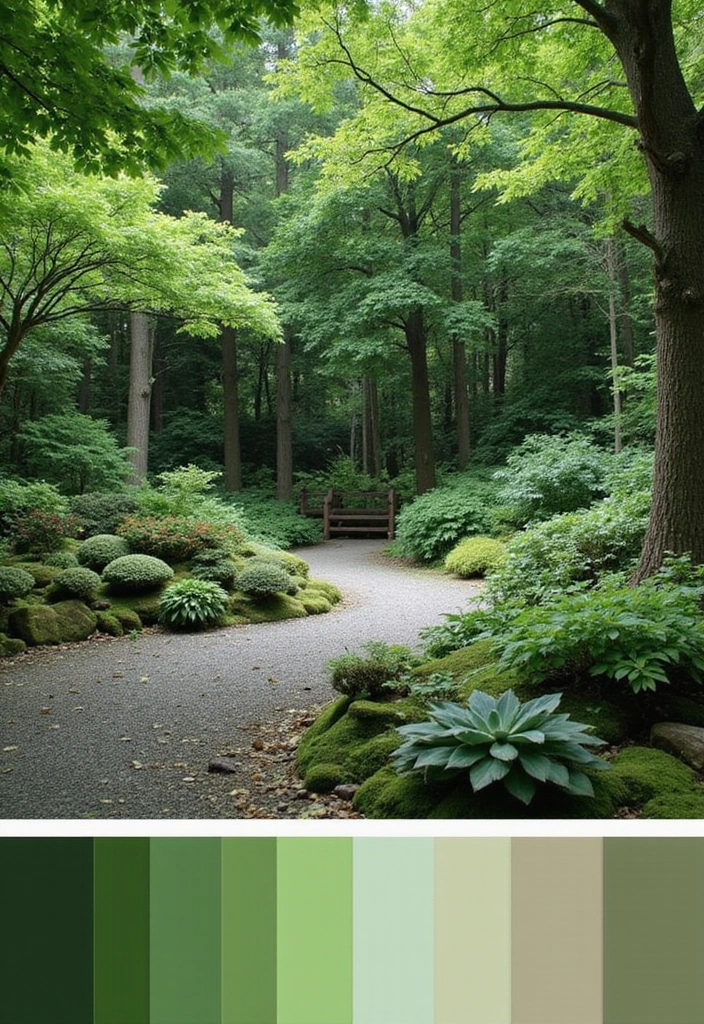
In a zen garden, color harmony plays a vital role in creating a soothing atmosphere. The goal is to use colors that complement rather than clash, fostering a sense of unity.
To achieve this color harmony, consider limiting your palette to a few key tones. Shades that evoke calmness, such as greens, blues, and earthy tones, are ideal. You might also want to introduce pops of color through seasonal flowers for added variety. A great way to do this is by using colorful garden flower seeds like the HOME GROWN USA PREMIUM Zinnia Dahlia Seeds. These vibrant Zinnia Elegans are perfect for pollinator gardens, borders, and containers, bringing cheerful bursts of color while remaining easy to grow.
Additionally, to deepen your understanding of creating a harmonious garden space, consider picking up the book garden color palette guide book. This resource will provide you with further insights into designing and maintaining your dream garden, ensuring that your color choices contribute to a tranquil experience.
A harmonious color scheme enhances the serene ambiance of your garden, making each visit a peaceful escape.
13. Zen Zones

Creating distinct ‘zen zones’ within your garden can enhance its functional and aesthetic appeal. Each zone can serve a specific purpose, allowing for different activities such as meditation, reflection, or simply enjoying nature.
Here’s how to create zen zones:
– Designate areas for seating, such as an outdoor garden bench, which offers a weatherproof and heavy-duty option for relaxation.
– Introduce small nooks with lush plants for private reflection, complemented by meditation cushions. These cushions provide adjustable support and comfort, perfect for settling into a tranquil moment.
– Use decorative garden rocks to delineate different zones. These polished stones not only enhance the visual appeal of your garden but also serve as natural pathways, guiding visitors through your serene space.
These zones promote a mindful experience, allowing visitors to engage with the garden in various ways, making it an ideal retreat for reflection and relaxation.
14. Incorporating Art
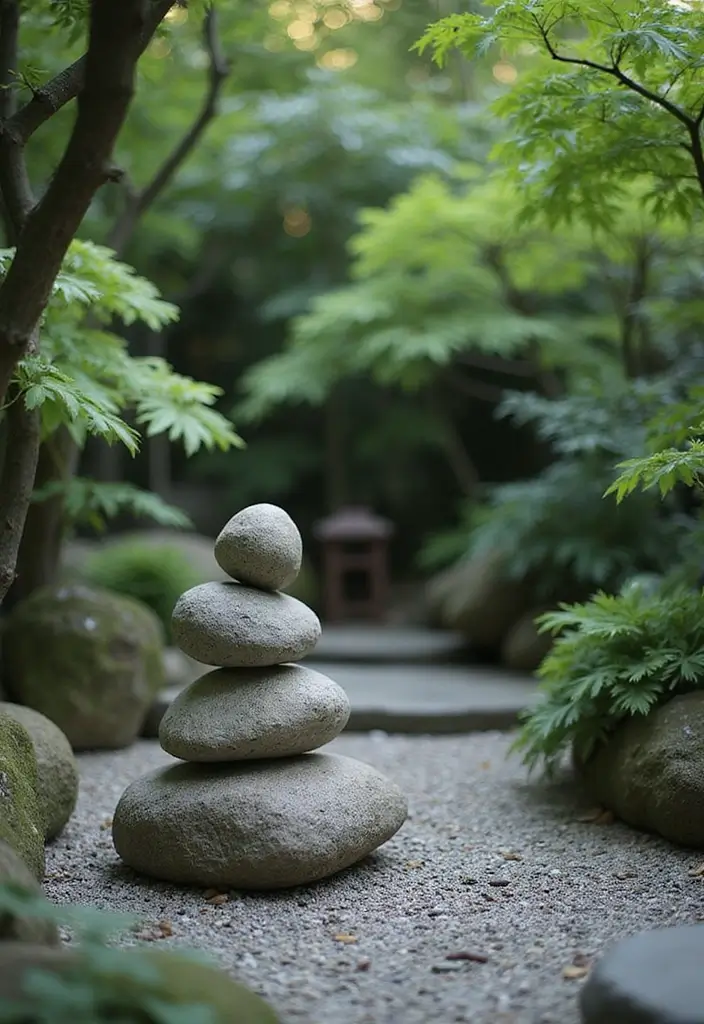
Art can bring a profound element to your zen garden, adding a personal touch and inviting contemplation. Whether it’s sculptures, wind chimes, or stone lanterns, art should enhance rather than dominate the space.
To integrate art into your garden:
– Choose pieces that resonate with you and reflect your style. For instance, the Ancient Graffiti eight-stone balancing cairn serves as a beautiful garden sculpture that symbolizes balance, encouraging a sense of tranquility.
– Position art in relation to natural elements for balance. Incorporating wind chimes can add soothing melodic tones to your garden, enhancing the serene atmosphere while gently moving with the breeze.
– Keep the overall aesthetic in mind, ensuring art complements the tranquil vibe. A solid rock stoneworks medium Japanese lantern not only serves as a functional light source but also as an elegant focal point, embodying the beauty and impermanence of nature.
Art serves as a reminder of beauty, encouraging a deeper connection with the garden.
15. The Role of Light
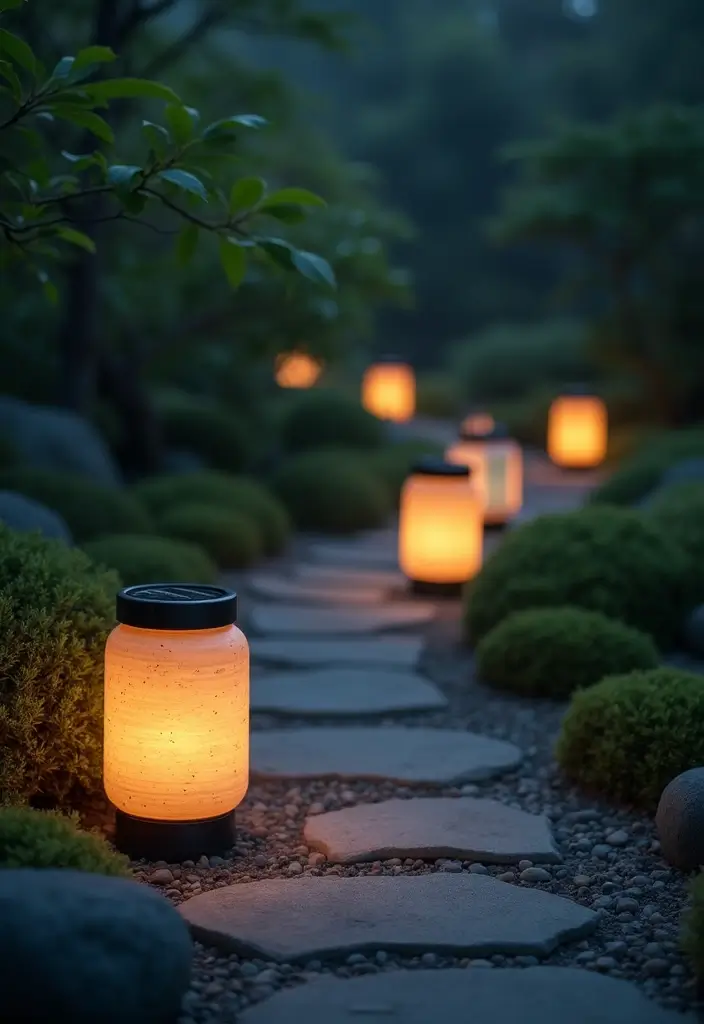
Lighting can greatly influence the atmosphere of your zen garden, extending its beauty into the evening hours. Soft, diffused light can create a magical ambiance that invites exploration and relaxation.
Here are some tips for using light effectively:
– Utilize solar garden lights to minimize environmental impact. These lights are perfect for illuminating pathways and flowerbeds while adding a whimsical touch to your garden.
– Position lights to highlight paths and focal points, ensuring that your garden remains inviting after sunset.
– Consider using decorative lanterns with LED pillar candles for a warm, inviting glow. These lanterns not only enhance the aesthetic of your space but also provide an efficient, battery-powered lighting solution that creates a cozy atmosphere.
Well-placed lighting enhances the serenity of your space, allowing you to enjoy its beauty day and night.
16. Incorporating Texture

Texture brings depth and interest to your zen garden. By combining various textures—such as smooth stones, rough bark, and soft foliage—you create a multi-sensory experience that enriches the garden’s aesthetic.
When focusing on texture, consider using coarse gravel for pathways, which provides a stark contrast to the smoothness of smooth river pebbles. The coarse gravel can create an inviting path through your garden, while the river pebbles add a polished touch that enhances visual appeal.
Incorporate plants with different leaf shapes and surfaces, such as assorted succulent plants. Their diverse textures—from the fleshy surfaces of succulents to the intricate designs of their leaves—can bring vibrancy and life to your garden.
Layering these textures not only creates visual intrigue but also adds comfort, inviting visitors to engage with the landscape. The harmony of textures contributes to the overall serene atmosphere, enhancing the tactile experience as you explore your tranquil space.
17. Wind and Sound

Incorporating elements that interact with wind and sound can elevate the experience of your zen garden, creating a multi-sensory dimension that enhances tranquility. Consider adding wind chimes, which produce deep, soothing melodic tones as they catch the breeze, further enriching the garden’s peaceful ambiance. Placing these chimes near seating areas allows you to immerse yourself in their calming sounds while you relax and unwind.
Another fantastic addition is a water fountain. The gentle flow of water creates a relaxing backdrop, and its tranquil sound can drown out any harsh noises, enhancing your garden’s serene atmosphere. A fountain not only serves as a visual focal point but also facilitates a more immersive auditory experience.
Additionally, consider incorporating swaying ornamental grasses. These plants respond beautifully to gentle winds, contributing soft rustling sounds that invite interaction and create a harmonious connection with nature. Together, these auditory elements contribute to a richer sensory experience, elevating the overall tranquility of your zen garden.
18. Seasonal Decor
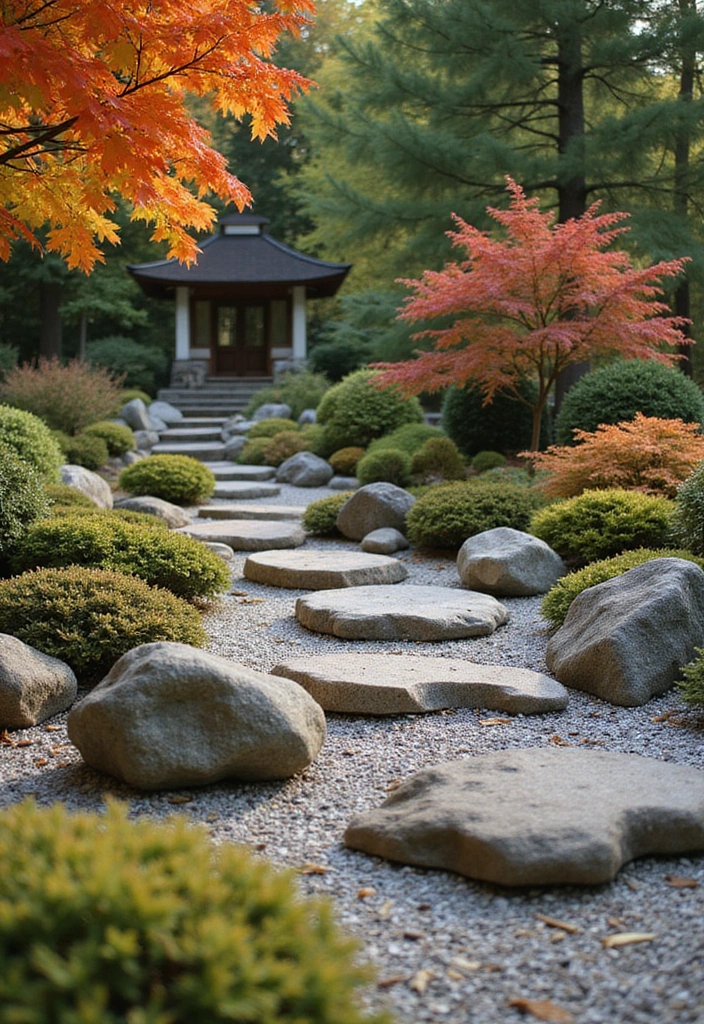
Seasonal decor that reflects the changing times of the year can add a dynamic element to your zen garden. This can range from the placement of seasonal plants to decorations made from natural materials. For instance, consider using seasonal decorative pumpkins in the fall to create a warm, inviting atmosphere. These artificial pumpkins are made from soft velvet foam, making them a durable choice that complements the autumn landscape beautifully.
In winter, incorporating items like snow-covered branch decor can enhance the serene feel of your garden. These frosted artificial pine needles add a touch of winter magic, allowing you to enjoy the beauty of the season without the upkeep of real branches.
As spring arrives, you might want to introduce natural dried flowers that bloom in your region. Their natural appearance and variety of colors bring life to your garden, signaling the renewal of nature.
These seasonal decor elements not only enhance the visual appeal of your zen garden but also deepen your connection to nature’s cycles, inviting ongoing appreciation and mindfulness.
19. Outdoor Seating Areas
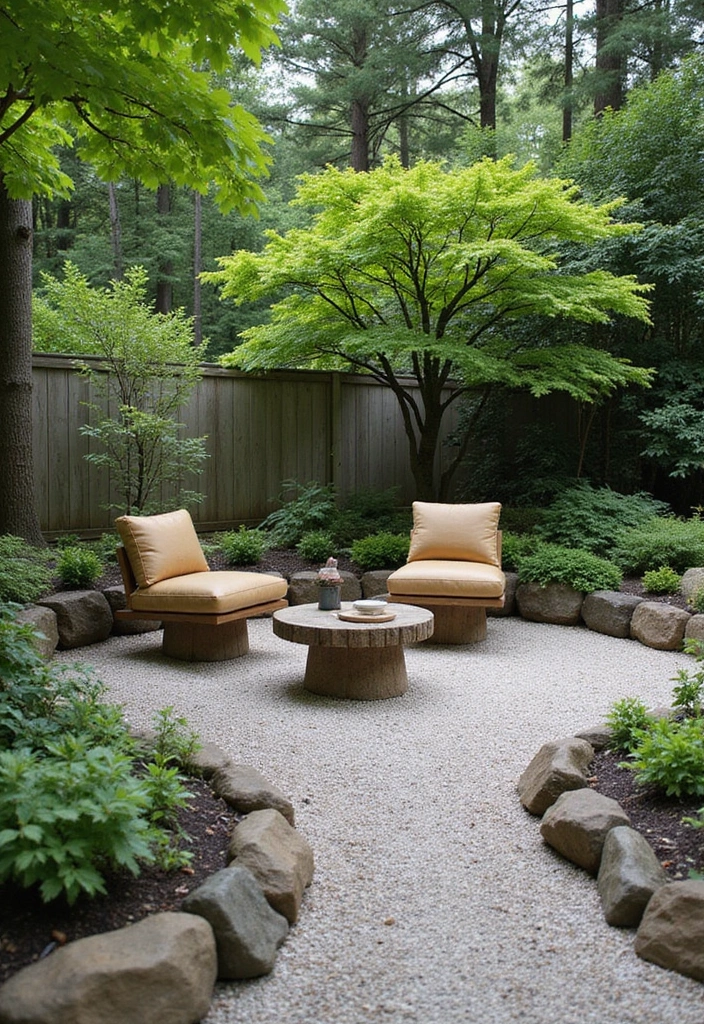
Creating inviting seating areas encourages people to spend time in the garden, promoting reflection and relaxation. Comfortable seating fosters mindfulness, making it an integral aspect of zen garden design.
Here are some tips for effective seating:
– Use natural materials like wood or stone that blend with the environment. A great option is the Wooden Garden Bench, crafted from acacia wood. Its sturdy design and beautiful finish make it perfect for enjoying the tranquility of your garden.
– Position seating to face focal points or views. For a unique touch, consider the Natural Stone Garden Stool. With its lightweight concrete construction and elegant gold patina finish, it can easily be moved to highlight your favorite garden view.
– Keep seating arrangements intimate and cozy, inviting conversation or solitude. Enhance comfort with the Cozy Outdoor Throw Pillows. These waterproof pillows bring a pop of color and softness, making your seating area even more inviting.
These areas serve as peaceful retreats, enhancing the overall tranquility of the space.
20. Element of Surprise
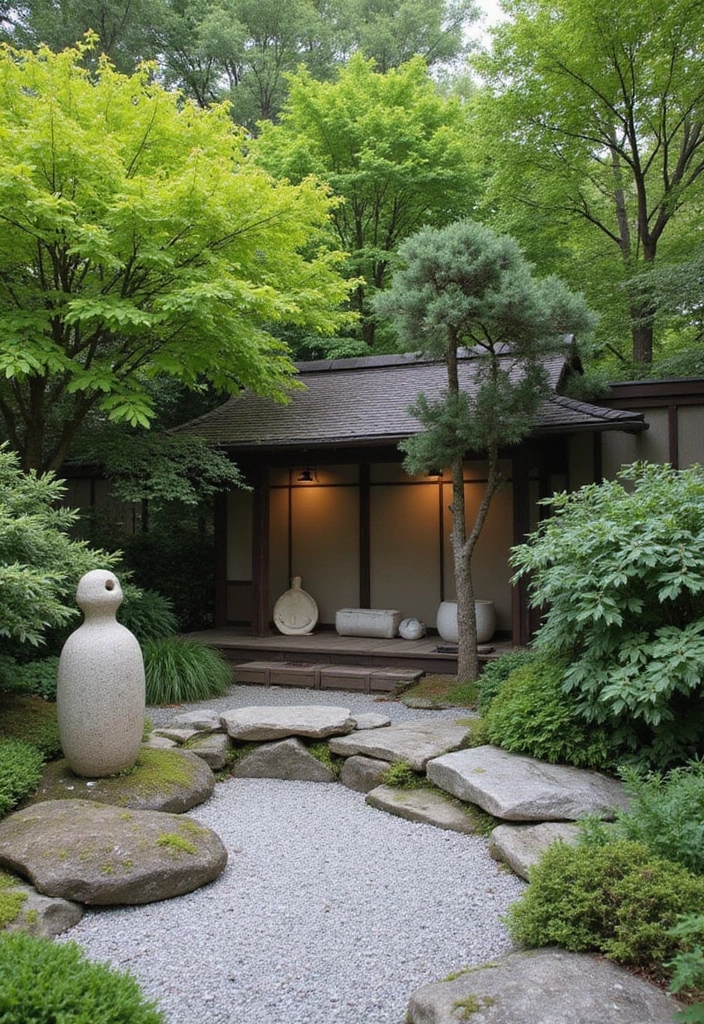
Adding an element of surprise can make your zen garden more engaging and delightful. This could be an unexpected sculpture, a hidden seating area, or unique plant arrangements. For instance, consider incorporating a whimsical touch with a whimsical garden sculpture like the Carruth Studio Too Much Fun, Green Man Plaque. This handmade stone piece can spark curiosity and serve as a delightful focal point in your garden.
Additionally, creating a cozy nook encourages visitors to explore. An ideal choice for this is an outdoor garden seating option like the iron steel frame patio bench. Its unique mesh pattern and comfortable design make it perfect for relaxing while surrounded by nature.
To further enhance the element of surprise, consider utilizing varied plant heights or unexpected textures. A great way to achieve this is by introducing the varied height plant set that includes an assortment of houseplants. This set can add depth and vibrancy to your garden, inviting exploration and engagement.
These surprises encourage curiosity and deeper engagement, adding layers of enjoyment to the zen experience.
21. Community Involvement

Engaging your community in the creation or maintenance of the zen garden can foster connections and provide a sense of shared ownership. Community gardens promote collaboration and establish a deeper bond with nature.
Here are some ways to get the community involved:
– Host planting days to involve local volunteers. To make these events easier and more enjoyable, consider using a garden tools set, which includes a variety of heavy-duty hand tools that will help participants work efficiently and comfortably.
– Offer workshops on sustainable practices, including composting. A great resource for this is the garden workshop guidebook, which provides insights on how to design and teach educational workshops effectively, ensuring that your community learns best practices.
– Create a shared maintenance schedule to encourage ongoing participation. Incorporating a composting bin can also be beneficial; it not only helps manage green waste but also engages community members in sustainable practices, enhancing their connection to the garden.
Community involvement enhances the garden’s social value, transforming it into a cherished gathering space.
22. Seasonal Events

Hosting seasonal events in your zen garden can strengthen community bonds and promote mindfulness. These gatherings invite people to connect with each other and the natural world, enhancing the garden’s role as a tranquil retreat.
To create the perfect atmosphere for these events, consider incorporating some helpful products. For instance, organizing mindfulness meditation sessions in spring can be made more comfortable with meditation cushions. The Retrospec Sedona zafu cushion provides excellent support and comfort, allowing participants to fully immerse themselves in their meditation practice.
In the summer, you might want to host outdoor movie nights under the stars. A great way to enhance this experience is by using a portable outdoor movie projector. The HAPPRUN Bluetooth projector is perfect for projecting films on a large screen while surrounded by the beauty of nature, creating a cozy and enjoyable atmosphere for everyone.
As autumn approaches, planning a harvest celebration with community potlucks is a wonderful way to gather together. To add a magical touch to the evening, consider hanging some outdoor string lights. These lights create a warm and inviting ambiance, making your garden the perfect setting for enjoying good food and company.
By incorporating these elements into your seasonal events, you can foster a sense of community while promoting mindfulness and connection to the natural world.
23. Learning Opportunities

Creating educational opportunities within your zen garden can transform it into a hub for learning about sustainable practices and gardening techniques. Offering workshops and guided tours can enrich the community’s knowledge and foster a deeper connection to nature.
Consider providing composting workshops to demonstrate sustainable practices, using a composting bin that makes it easy to manage organic waste. This bin has a dual rotating feature, allowing for efficient composting and helps participants learn about the benefits of recycling organic matter.
Additionally, gardening classes can focus on native plants, and utilizing a gardening tool set can enhance the experience. This 8-piece set comes with ergonomic handles and is designed for heavy-duty use, making it perfect for both new and experienced gardeners.
Finally, guided meditative walks can teach mindfulness techniques. Participants can sit comfortably on a meditation cushion, which provides a cozy spot to practice mindfulness amidst the tranquility of the garden.
These opportunities not only enhance the garden’s value but also promote sustainability and a deeper connection to the natural world.
24. Mindfulness Practices
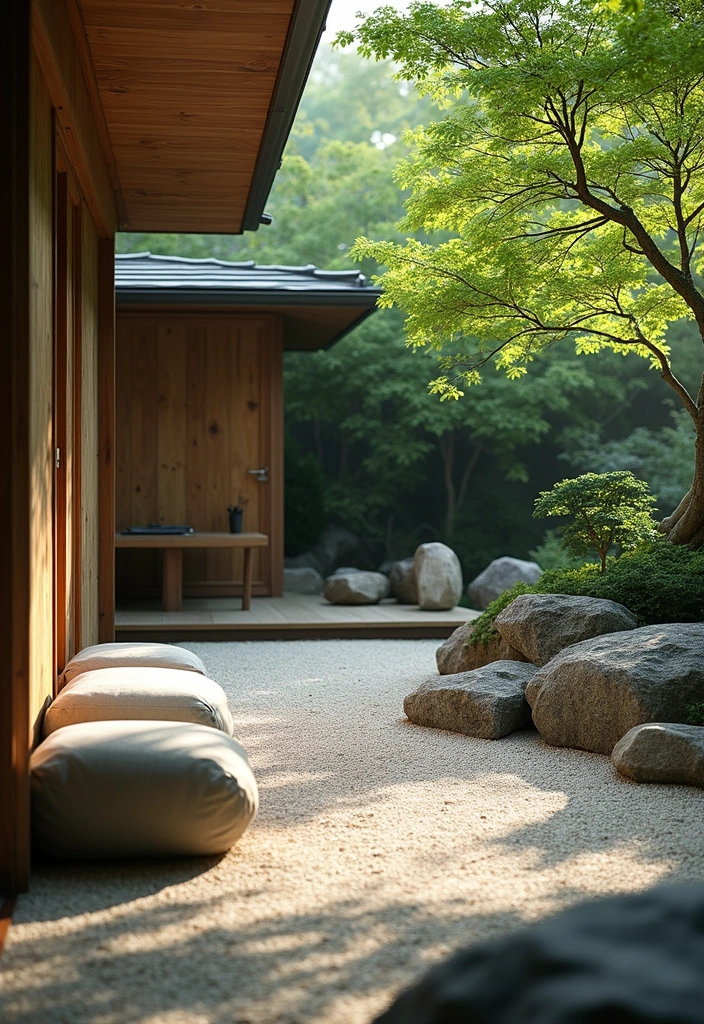
Incorporating mindfulness practices into your zen garden can create a sacred space for reflection and inner peace. This can include meditation spots or quiet areas for contemplation.
Here are some ideas to enhance mindfulness:
– Designate specific areas for meditation or quiet reflection. Consider adding a comfortable meditation bench. Made from sustainable acacia wood, it features curved bottom edges that support perfect posture during your practice.
– Incorporate elements like wind chimes to enhance the calming atmosphere of your garden. The deep tone and soothing melodic sounds create a serene backdrop that can aid in relaxation and focus.
– Use garden cushions for added comfort while sitting or kneeling during meditation or contemplation. These soft foam cushions are perfect for ensuring a comfortable experience as you connect with your surroundings.
These practices encourage patrons to engage fully with their environments, promoting serenity and balance.
25. Nature Integration
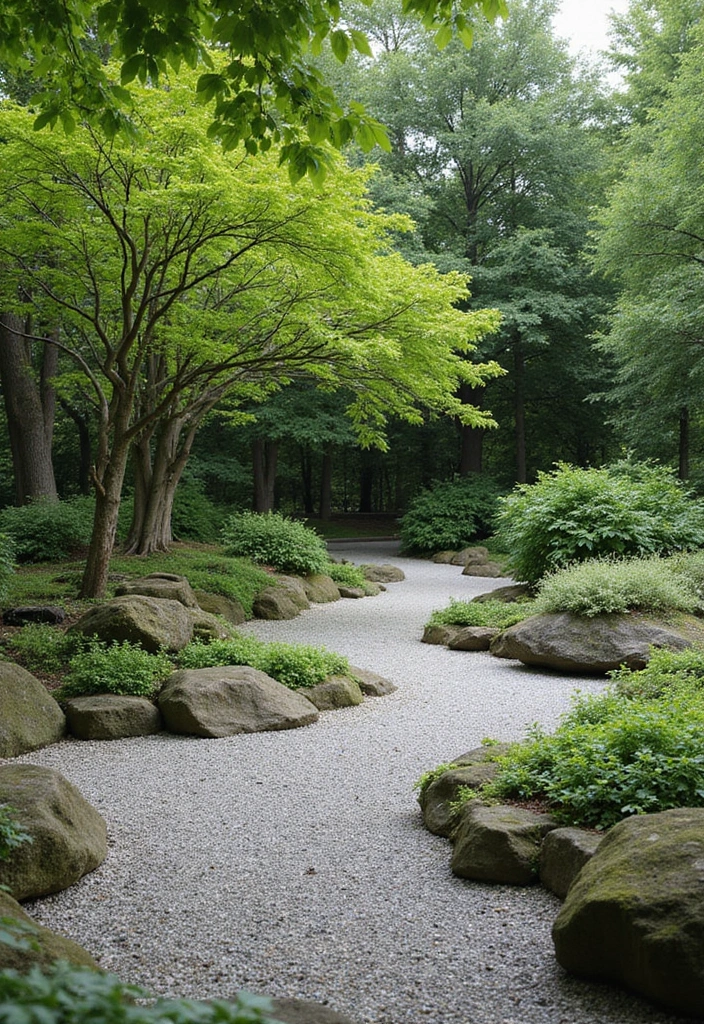
Integrating the natural environment into your zen garden can enhance its beauty and significance. This means designing with the existing landscape in mind and allowing nature to dictate certain elements.
To achieve a natural integration:
– Observe the natural flow of land and water. Consider adding a soothing element with a water feature kit like a bamboo accents zen garden fountain. It not only adds tranquility but also harmonizes beautifully with the surrounding environment.
– Use native plants that thrive in your climate. A good choice is the native plant seed pack, featuring blue vervain seeds. These wildflowers attract butterflies and naturally fit into the landscape, enhancing your garden’s ecological balance.
– Allow natural features, like existing trees or rocks, to dictate your layout. Incorporating garden rocks and stones can help define pathways and add texture. These polished natural stones create visual interest while blending seamlessly with the natural elements.
By harmonizing with nature, you create a garden that feels organic and connected to its surroundings.
26. Sustainable Practices
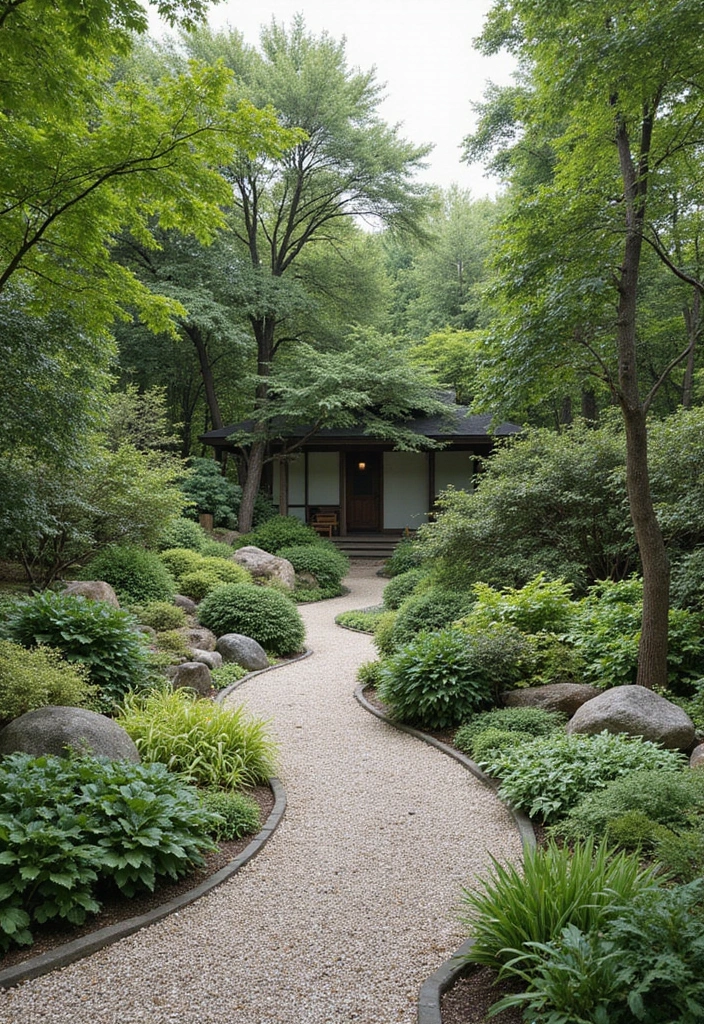
Emphasizing sustainable gardening practices within your zen garden not only benefits the environment but also aligns with the garden’s spirit. This includes using eco-friendly materials, maintaining biodiversity, and reducing waste.
To adopt sustainable practices:
– Use True Organic All Purpose Plant Food, an organic fertilizer that enriches your garden with nutrients while avoiding harmful chemicals. This helps your plants thrive naturally.
– Collect rainwater with a VEVOR Collapsible Rain Barrel. This 53-gallon system makes it easy to conserve resources by capturing rain for irrigation, ensuring your garden stays lush while being eco-friendly.
– Design plantings to attract beneficial insects and wildlife by incorporating a Lulu Home Wooden Insect House. This habitat provides shelter for bees, butterflies, and ladybirds, which are vital for pollination and maintaining a balanced ecosystem.
Sustainability promotes longevity and connection to the earth, making your zen garden a true sanctuary.
27. Personal Reflection

Lastly, creating a zen garden is a deeply personal journey. Allow your space to reflect your values, experiences, and wishes. This means adding elements that resonate with you and encourage introspection.
For instance, consider using a zen garden sand rake to shape the patterns in your garden’s sand or gravel. This tool is not only functional but can also be a way for you to express your creativity and personal style through the designs you create.
You might also want to add some color and vibrancy with decorative stones for zen garden. These glow-in-the-dark pebbles are perfect for bringing a unique touch to your space, allowing you to create pathways or accents that are both beautiful and meaningful.
Additionally, incorporating a buddha statue for your garden can serve as a focal point for meditation and reflection. This element can symbolize serenity and mindfulness, enhancing the tranquil atmosphere of your garden.
Allow the garden to evolve as your experiences and needs change. Your zen garden should be a sanctuary that grows with you, becoming a cherished space for serenity and balance.
Your zen garden is a mirror of your journey; let each element tell your story and invite introspection. Create a sanctuary that evolves with you, reflecting your unique values and experiences.
Conclusion
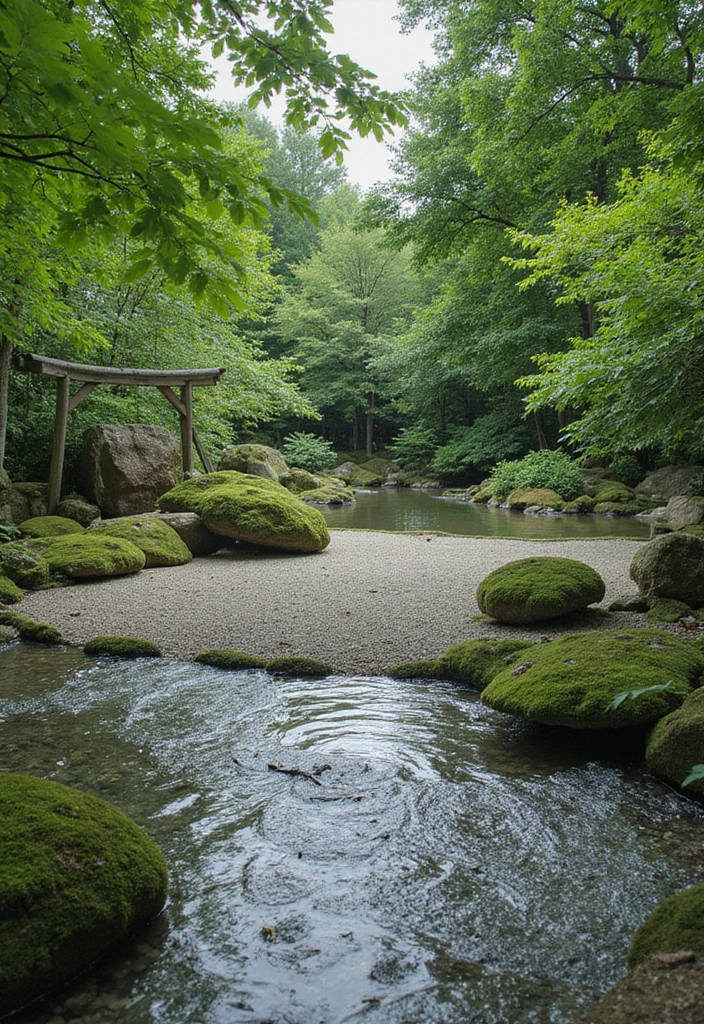
Designing a zen garden is a beautiful journey that promotes serenity and balance in your life. By applying these 27 principles, you can create a space that invites mindfulness and fosters a connection with nature. Whether through sustainable practices or thoughtful design choices, your zen garden can become a sanctuary of peace.
Engaging with your garden allows for ongoing reflection and appreciation. Consider how you might apply these ideas to your own space and enjoy the tranquility that follows.
Note: We aim to provide accurate product links, but some may occasionally expire or become unavailable. If this happens, please search directly on Amazon for the product or a suitable alternative.
This post contains Amazon affiliate links, meaning I may earn a small commission if you purchase through my links, at no extra cost to you.
Frequently Asked Questions
What Are the Key Elements to Consider When Designing a Zen Garden?
Designing a zen garden involves several key elements that foster tranquility and balance. Start with a minimalist aesthetic, focusing on simplicity and clean lines. Incorporate a thoughtful balance of elements such as rocks, plants, and water features to create harmony. Pathways also play a crucial role in guiding visitors through the garden, promoting a mindful journey.
Additionally, consider the choice of materials, opting for natural options like wood and stone, to enhance the organic feel of the space.
How Can I Incorporate Sustainable Gardening Practices into My Zen Garden?
Incorporating sustainable gardening practices into your zen garden is a rewarding endeavor! Start by embracing organic waste management through composting, turning kitchen scraps into nutrient-rich soil. Use eco-friendly materials for pathways and features, and focus on native plants that thrive in your local climate, reducing the need for excessive watering.
These practices not only benefit the environment but also align beautifully with the peaceful essence of a zen garden.
What Are Some Mindfulness Practices I Can Incorporate in My Zen Garden?
Your zen garden can be a wonderful space for mindfulness practices. Create designated areas for meditation or quiet reflection, perhaps with comfortable seating or a simple cushion.
Incorporate elements that engage the senses, like wind chimes for soothing sounds or fragrant plants for pleasant aromas. Regularly practice mindful walking along the pathways, allowing yourself to focus on the experience of each step and the beauty around you.
How Do I Choose the Right Plants for My Zen Garden?
Choosing the right plants for your zen garden is essential for maintaining a serene atmosphere. Aim for a selection of plants that offer varied textures and colors while promoting harmony. Opt for low-maintenance, drought-resistant plants that align with your local climate.
Consider incorporating plants with symbolic meanings, such as bamboo for resilience or lotus for purity, to deepen the sense of tranquility in your space.
What Role Does Maintenance Play in Zen Garden Design?
Maintenance is a vital aspect of zen garden design that can actually enhance your experience. Rather than viewing it as a chore, embrace it as a mindful practice. Regularly tending to the garden allows you to connect with your space and reflect on your thoughts.
Simple tasks like raking gravel, pruning plants, or cleaning water features can be meditative acts that reinforce the garden’s tranquility and balance, making maintenance a rewarding part of your zen journey.
Related Topics

